Using Nero InfoToolOriginal Page URL: https://www.digital-digest.com/articles/using_nero_infotool_page1.htmlAuthor/Publisher: jmet Date Added: Sep 1, 2006 Date Updated: Sep 1, 2006
Software you will need:
broken link new link ftp://ftp6.nero.com/tools/InfoTool.zip The Nero Info Tool utility retrieves your computer system information. This information includes system drives, operating system, drivers listing, etc. This program analyzes and displays the main characteristics of drives, disks and the installed software. This information can also be printed or saved to a text file. It can analyze and display important information about the media currently in the drive, whether it be a blank DVD or a previously burned DVD. It works for DVD-R, DVD-RW, DVD-R DL, DVD+R, DVD+RW, and DVD+R DL media. It will tell you if its single layer, dual layer, or double layer. It list all the burning speeds that is supports. It also gives the total blank capacity of the disc. It gives you the "Manufacturer ID" (aka Media ID) of the disc so that you can see who actually makes the dye. Furthermore it will list all "video" and "audio" codec you have installed. Very handy if you are trying to determine if you have a specific codec installed or not. If you have Nero installed on your system, chances of having Nero InfoTool is almost certain. To start it, click "Start", then go to "All Programs" or "Programs", then click "Ahead" or "Nero", then click Nero Toolkit, then click "Nero InfoTool". As soon as you start it up, it will "analyze" your system and gather all the necessary information it needs. (Screen Shot Below) 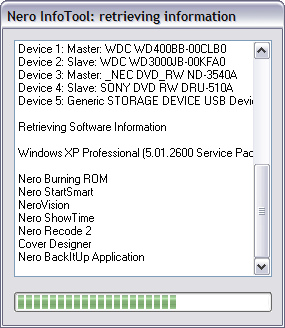 It will then present you with this screen with 7 tabs at the top (red) that cover specific areas. It also has 3 useful buttons located at the top, the "Save As" button, the "Print" button, and the "Refresh" button (blue). If you have more than 1 drive installed on your computer, you need to select the appropriate drive so that InfoTool can correctly tell you the limitations of that drive(green). (Screen Shot Below) 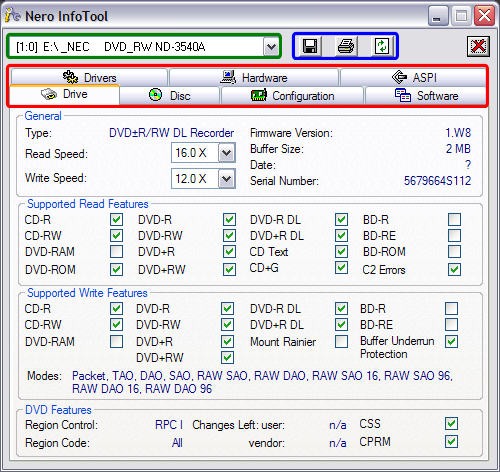
Drive Tab
This is the tab you need to click to basically see what your drive is and isn't capable of doing. It tells you the max "Read" and "Write" speeds of the drive (gold). It tells you the current firmware you have installed for the drive (purple). You are mainly concerned with "Supported Features" section (red). It will list all features for both "Read" and "Write" and if your screen has a green check mark in the box, that means your drive supports that feature (blue), if the box is empty then it doesn't support it (green). (Screen Shot Below) 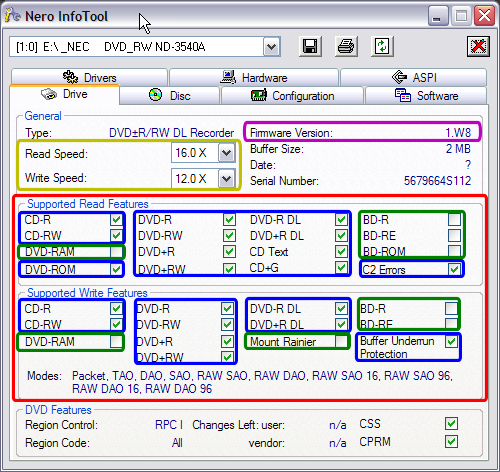
Disc Tab
This is the tab you would need to click on to find out specific information about the media currently in that drive. In my screen shot I have a disc that was previously burnt to. This tab is basically self explanatory but, it gives you the "Title" of the DVD, that date it was burnt, the file system (a standard DVD-Video should be UDF 1.02 or ISO/UDF 1.02 bridge), the disk capactity, and which program was used to burn it (red). (Screen Shot Below) 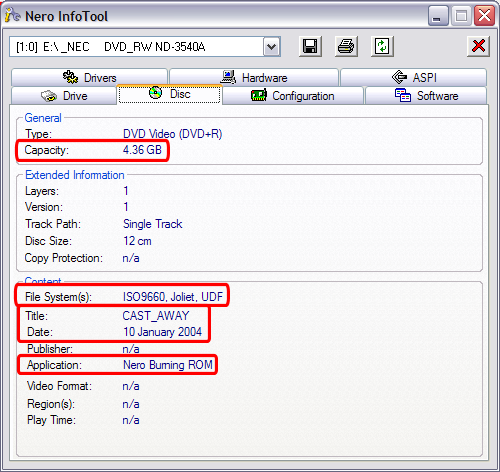
Configuration Tab
Here on this tab it shows you got your hard drives & optical drives (CD-ROM/DVD+RW drives) setup and on which IDE channel they are on. One thing to definitely look at is "DMA", and see if its turned on "On" (red). If its off, go here to learn how to turn it back on. (Screen Shot Below) 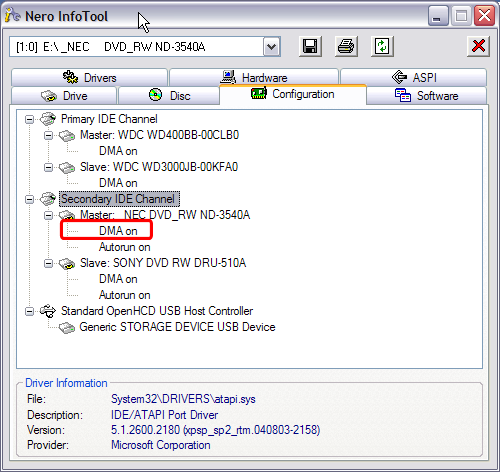
Software Tab
Here on this tab it tells you what Operating System (OS) you are using (red), what version of Direct X you are running (blue), and it list all "Nero" applications that you currently have installed (green). (Screen Shot Below) 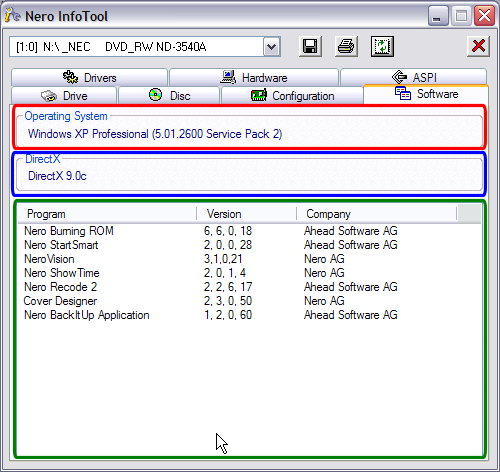
Drivers Tab
On this tab it will list all the drivers you currently have installed (red), as well as all the "Audio" ( blue) & "Video" codec you have installed (green). (Screen Shot Below) 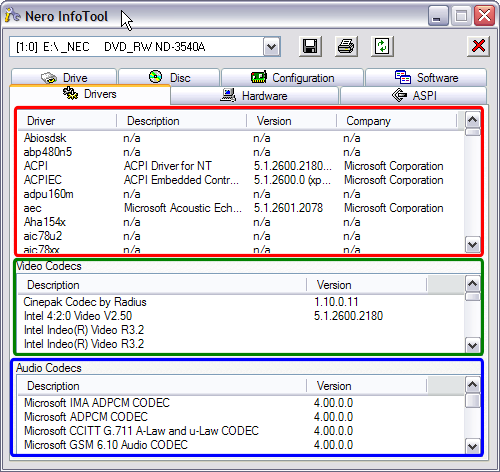
Hardware Tab
This tab just displays the basic information about your computer such as what CPU you have (red), what brand and model number motherboard you have (blue), how much memory (RAM) you have installed (green), and your what Sound card and Video card you have (purple). It also tell you vital BIOS information (gold). (Screen Shot Below) 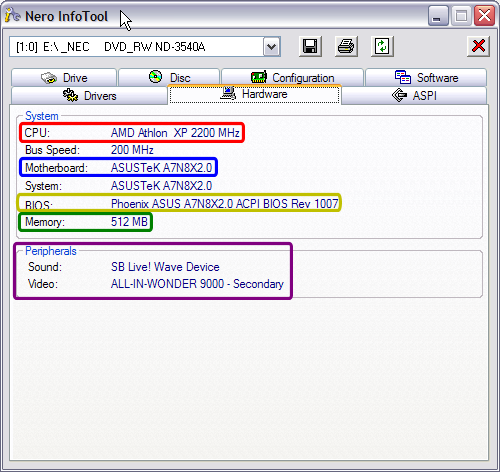
ASPI Tab
ASPI stands for Advanced SCSI Programming Interface. It is a software layer that enables programs to communicate with SCSI and ATAPI devices. Nero uses its own ASPI so if one doesn't show up there under "System ASPI", just click the down arrow and change it to "Nero ASPI" (red). (Screen Shot Below) 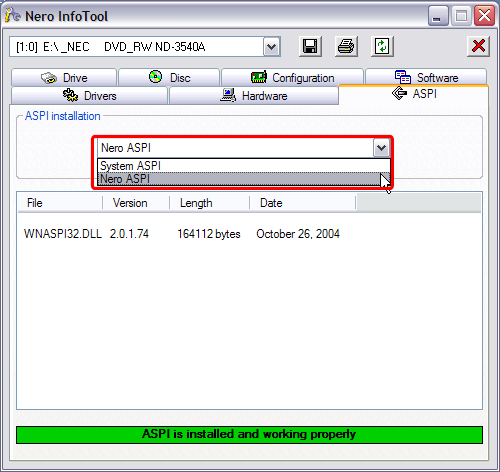
From time to time, you may need to report certain information to someone, like which IDE channel your DVD burner is on. Here is where you would use Nero's InfoTool. Click the "Save" button (red). (Screen Shot Below)
 After clicking the "Save" button, this screen will come up. Here you can select which part of the report you wish to copy, most of the time it will be the "Configuration" section (red). Put a check mark in the appropriate box on which part you want to copy and then click the "Save" button (blue). You can use the "Preview" button to see what exactly will be copied at any time (green). (Screen Shot Below) 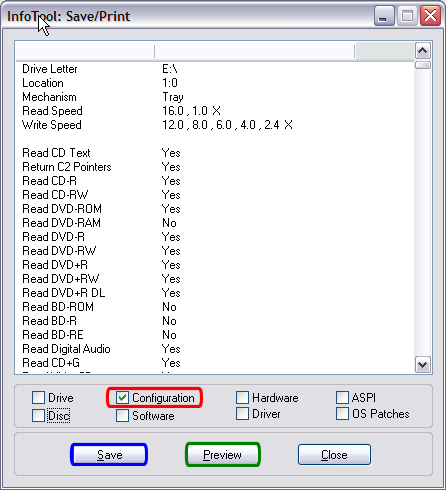 After saving, you should now have a .txt file all of your information you selected. Just open that up and highlight a certain part or highlight all of it, right click then "Copy" it, then come back to the forum and "Paste" it in a reply. (Screen Shot Below) 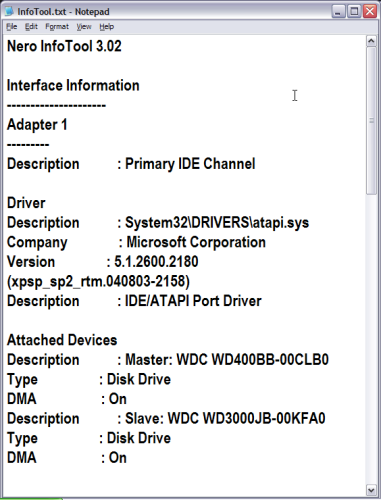
|